In heavy and especially extreme metal of the 1980s, new playing techniques emerged in the vocals, on the guitar and bass, and on the drums, and became style-defining characteristics of the newly emerging black metal, death metal, and grindcore (Berger 1999; Berger/Fales 2005; Pillsbury 2006; Elflein 2010).
During the 1980s, transgressive developments in drumming emerged that enabled the development of a new ‘foot virtuosity’ (Brennan 2020: 234).[1] Especially double bass and blast beat drumming became new standards for extreme metal.
The use of double bass dates to the 1940s and the drummer Louie Bellson as well as the manufacturer Gretsch (Brennan 2020: 225),[2] then became popular especially among fusion, progressive and hard rock drummers in the 1960s and 1970s (see ‘Fireball’ by Deep Purple, 1971). The double kick technique on the bass drum was then used frequently by Judas Priest (on Sin After Sin, 1977) and Motörhead (on ‘Overkill’) in the 1970s and became part of the musical language of heavy metal at the beginning around 1980 (Cope 2010, p. 100). While for example on Accept’s ‘Fast As A Shark’ from 1982 a regular sixteenth pulse at about 140 bpm was played, the tempo accelerated strongly with new styles like thrash metal.[3]
The development of the blast beat technique as a fast snare/bass drum interaction is far more controversial. Its beginnings can be traced back to free jazz recordings of the 1960s[4] as well as to jazz rock of the 1970s,[5] even though examples make use of a fast snare/bass drum interaction primarily as a dramaturgical and virtuosic means in the context of the accompaniment of a soloist.[6] While some further precursors are seen in progressive rock, this technique most probably developed on the basis of the established double bass playing in heavy metal, and the general tendency toward tempo increases in the 1980s (Mudrian 2006: 46-65). Uses of early blast beats in a clearly higher tempo can be found then in the hardcore punk of the early 1980s with bands such as Asocial (1982), D.R.I. or Heart Attack (1983).[7] In thrash metal, strongly influenced by hardcore punk, this style of playing emancipated and influenced the drumming of subsequent styles. One of the earliest examples is offered by Slayer’s Dave Lombardo, who since the album Hell Awaits (1984) regularly and for longer sections played eighth-note blasts at tempos above 200 bpm. Another early example of a blast beat variation would be the drumming on ‘Milk’ by S.O.D. at about 230 bpm (on Speak English Or Die, 1985).
The blast beat drumming can be categorised as follows:

Following Alan Moore (2012: 19-21) and his explanation of the relevance of texture to understanding music (he distinguishes between functional layers, aspects of music production, and timbre), I argue that a) these layers interlock heavily, and b) the playing techniques on the drums in particular contribute to the overall dissonant and ambigous texture of extreme metal together with distorted guitars and vocals (screaming, growling), and more complex approaches to harmony in general.
The following spectogram analysis will show the intensified spectral energy that can be heard already once the drumming switches to blast beats.
The drums are produced with Toontrack’s Superior Drummer in 120 bpm, using the MIDI Library „Library of the Extreme“, played by reowned drummer Dirk Verbeuren. The first 4 images show the applied 4 drum grooves: a simple back beat (1), an up-beat with intensified snare hits and double-bass (2), a blast beat in the variation no. 1 (3), and a blast beat in the variation no. 2 (4).
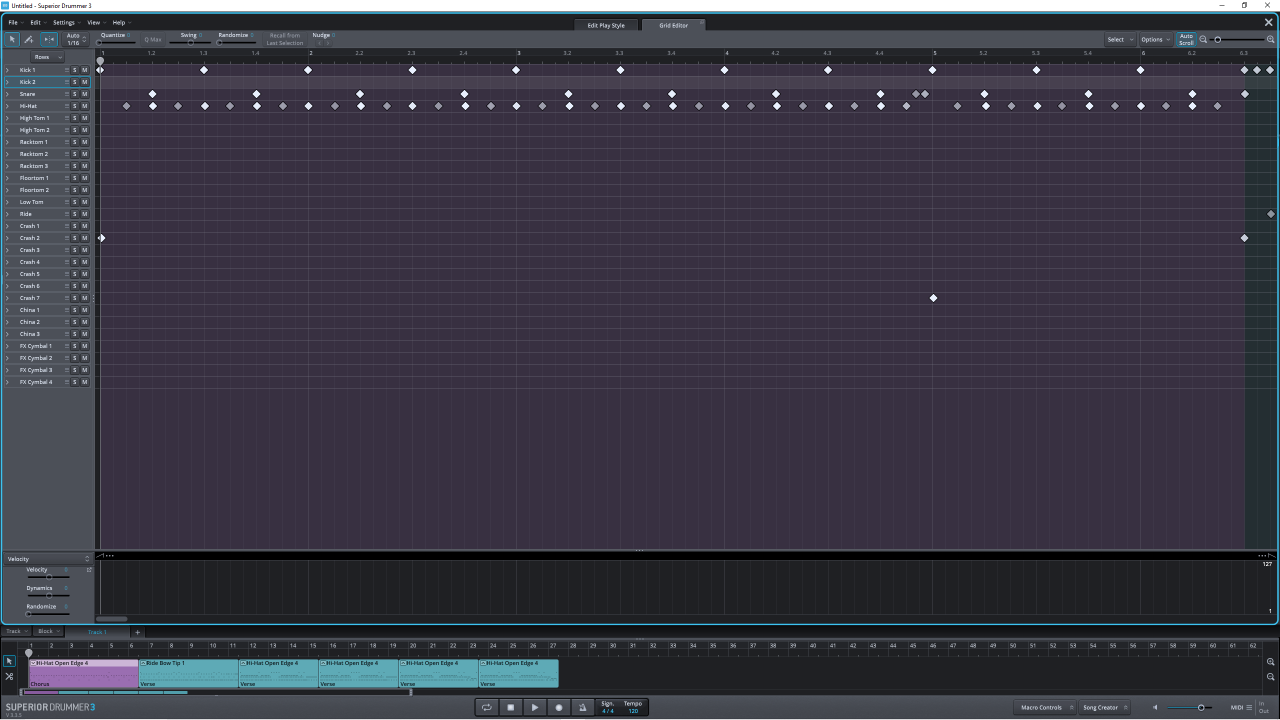
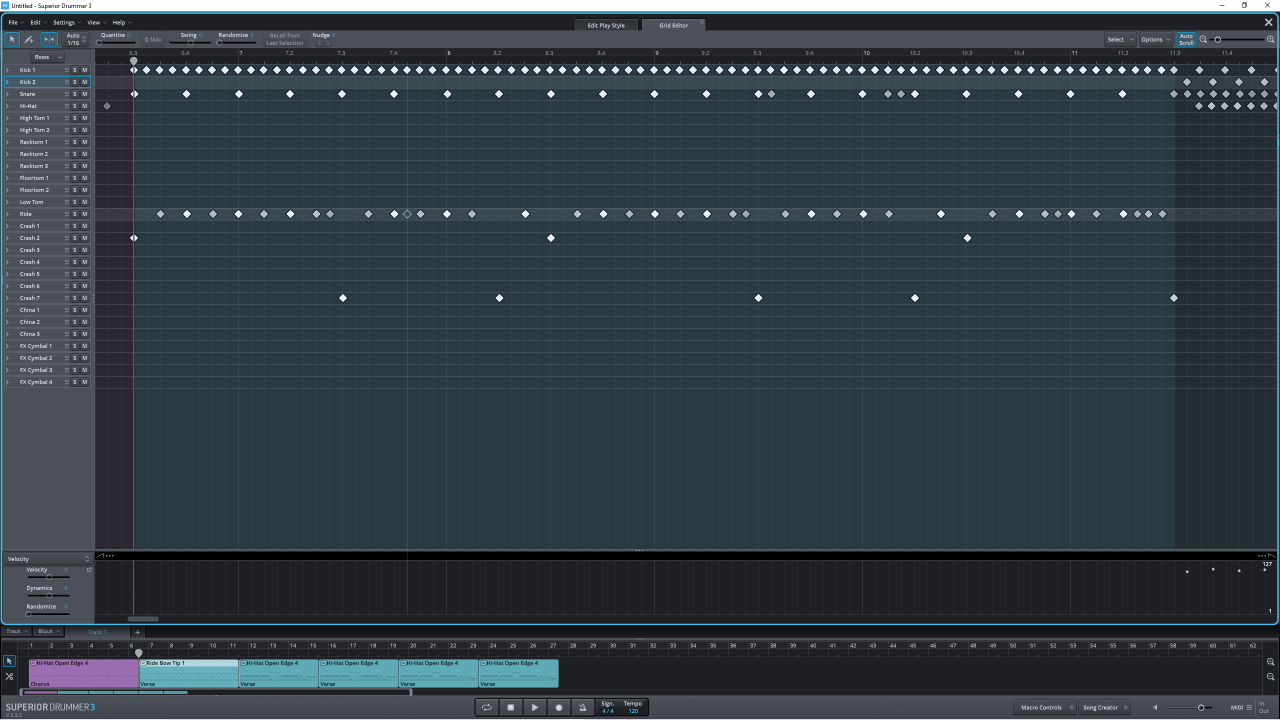
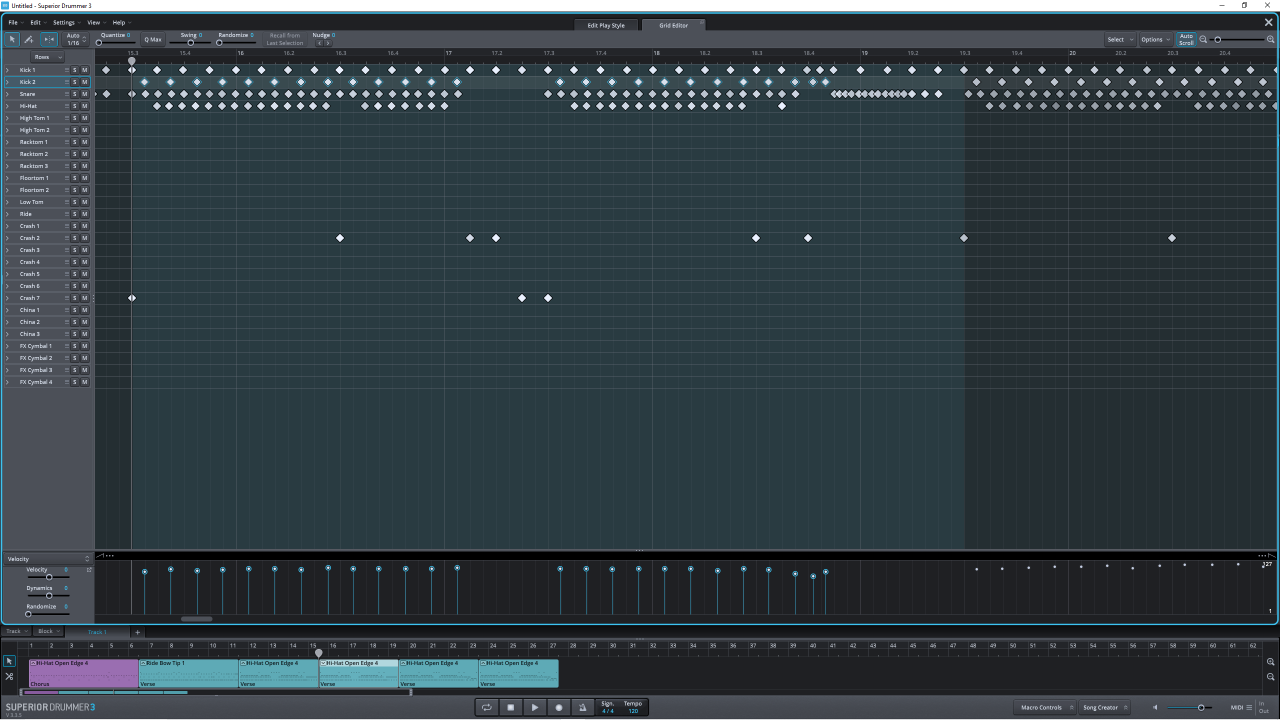
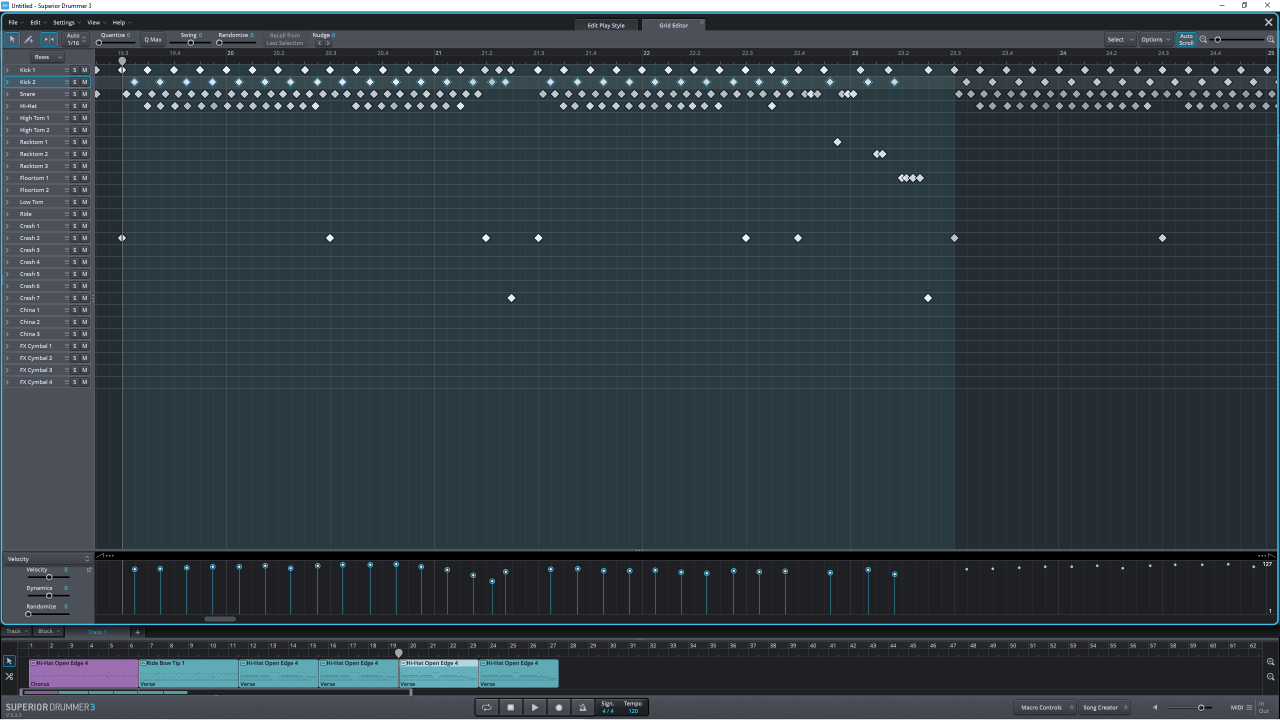
You can listen to the drum beats here:
In the following, you can see screenshots of the spectogram analysis (done with Sonic Visualiser). You see an excerpt of the lowest frequencies up to 3,5kHz. Green indicates low energy, yellow a certain amount of energy, and red high energy.
In the first image, you can see the first 2 drum beats. The back beat is cleary differentiable from the up-beat, especially the double kick drum figure stands out. The spectral energy cleary visualises the hits on the different parts of the drum kit.
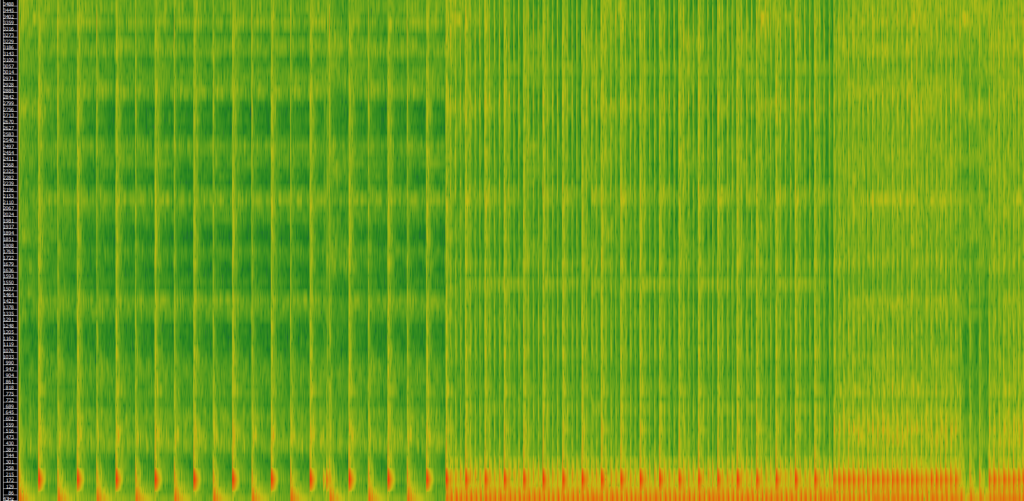
The 2nd image shows the 2 blast beat variations. It becomes clear that a lot more spectral energy is present to the faster stroke sequence on the different parts of the drumkit. The moments where there seems to be more „air“ are the drum fills at the end of an 8-bar phrase.
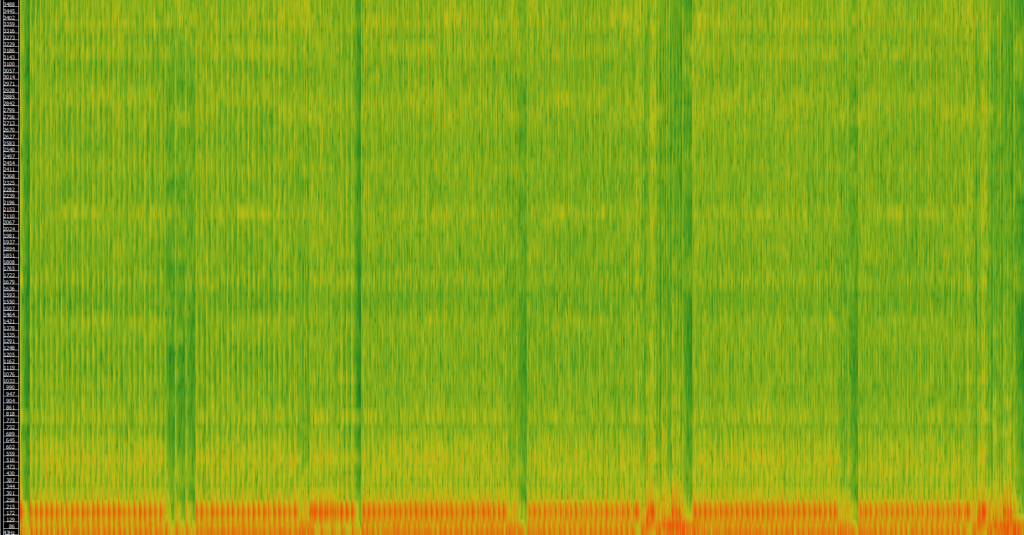
image 2: blast beat variations.
Bibliography
Brennan, M. 2020. Kick it: a social history of the drum kit. New York: University Press.
Berger, H. (1999). Metal, Rock, and Jazz. Middletown, CT: Wesleyan University Press.
Berger, H. and Fales, C. (2005). ‘“Heaviness” in the perception of heavy metal guitar timbres: The match of perceptual and acoustic features’, in T. Porcello and P. Greene (eds), Wired for Sound, Middletown, CT: Wesleyan University Press, pp. 181–97.
Boddington Jordan, Jamie and Herbst, Jan-Peter (2023). ‘Harmonic structures in twenty-first-century metal music: A harmonic analysis of five major metal genres’, Metal Music Studies, 9:1, pp. 27–58.
Cope, Andrew L. (2010): Black Sabbath and the rise of heavy metal music, Farnham: Ahsgate.
Elflein, Dietmar (2010). Schwermetallanalysen. Die musikalische Sprache des Heavy Metal. Bielefeld: transcript.
Moore, Alan (2012). Song Means. Analysing and Interpreting Recorded Popular Song, Farnham: Ashgate
Pillsbury, G. (2006). Damage Incorporated: Metallica and the Production of Musical Identity, New York: Routledge.
Zaddach, Wolf-Georg (2018). Heavy Metal in der DDR. Szene, Akteure, Praktiken, Bielefeld: transcript.
[1] The English term ‘blast beat’ is attributed, among others, to the U.S. drummer Eric Castro, who acquired the nickname ‘Dr. Blastbeat’ in the mid-1980s. Castro plays in the thrash/death metal band Majesty (today: Nausea), the first published recording Bestial Vomit was released in 1987.
[2] The use of the drum kit is documented, for example, in Bellson’s performance with the Duke Ellington Orchestra at the 1956 Newport Jazz Festival. During the drum solo in ‘Skin Deep,’ Bellson plays a fast quaver pulse for almost a minute with the help of two bass drums, cf. ‘Skin Deep,’ 1:08-2:06 min (on Ellington At Newport 1956, Columbia 64932, 1999).
[3] For example, Metallica played such a bass drum pulse at about 185 bpm on ‘Fight Fire With Fire’ in 1984, Slayer’s Dave Lombardo used the technique in ‘Angel Of Death’ in 1986 then at about 210 bpm.
[4] Sonny Murray’s playing in the live version of Albert Ayler’s ‘Holy Ghost’ in 1965 (Albert Ayler – Live In Greenwich Village. The Complete Impulse Recordings, Impulse 052 273-2, Track 1).
[5] Tony William’s playing on ‘Dark Prince’ on the album Trio of Doom Live by the Trio of Doom with John McLaughlin and Jaco Pastorius from 1979 (Columbia/Legacy 82796964502).
[6] Both use fast sequences of snare and bass drum hits exclusively for a short period of time and not with the velocity as it was established later. For an extensive musical analysis see Zaddach (2018: 295-296).
[7] An interesting overview of early recordings documenting blast beats can be found on fan pages like http://rateyourmusic.com/list/Iakov/a_short_history_of_blastbeats/ (accessed 22.07.2021).